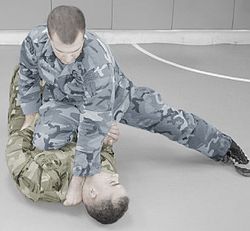Positional asphyxia

Positional asphyxia, also known as postural asphyxia, is a form of asphyxia which occurs when someone's position prevents the person from breathing adequately. A significant number of people die suddenly during restraint by police, prison (corrections) officers and health care staff.[1] Positional asphyxia may be a factor in some of these deaths.
- Positional asphyxia is a potential danger of some physical restraint techniques,
- People may die from positional asphyxia by simply getting themselves into a breathing-restricted position they cannot get out of, either through carelessness or as a consequence of another accident.
Prone restraint
Research has suggested that restraining a person in a face down position is likely to cause greater restriction of breathing than restraining a person face up.[2] Multiple cases have been associated with the hogtie or hobble prone restraint position.[3][4] Many law enforcement and health personnel are now taught to avoid restraining people face down or to do so only for a very short period of time.[1]
Risk factors which may increase the chance of death include prolonged (particularly resisted) restraint, obesity, prior cardiac or respiratory problems, and the use of illicit drugs such as cocaine.[5] Other issues in the way the subject is restrained can also increase the risk of death, for example kneeling or otherwise placing weight on the subject and particularly any type of restraint hold around the subject's neck. Research measuring the effect of restraint positions on lung function suggests that restraint which involves bending the restrained person or placing body weight on them, has more effect on their breathing than face down positioning alone.[6]
Other restraint positions
Positional asphyxia is not limited to restraint in a face down position. Restraining a person in a seated position may also reduce the ability to breathe, if the person is pushed forwards with the chest on or close to the knees. The risk will be higher in cases where the restrained person has a high body mass index (BMI) and/or large waist girth. [7]
Resuscitation
Resuscitation of persons who exhibit cardiac arrest following restraint has proven to be difficult. Even in cases where the subject was in the immediate care of paramedics, resuscitation has failed and the subject has died.[8] One group of doctors has presented a method of resuscitation, correcting acidosis in the blood of the victim, which proved effective in their small scale study.[9] This approach appears to be supported by another report of a single case of successful resuscitation.[10]
Debate regarding positional asphyxia
There is a degree of controversy amongst researchers regarding the extent to which restraint positions restrict breathing. Some researchers report that when they conducted laboratory studies of the effects of restraint on breathing and oxygen levels, the effect was limited.[11] Other researchers point out that deaths in real life situations occur after prolonged, violent resistance which has not been studied in laboratory simulations.[12]
Positional asphyxia due to accident or illness
Positional asphyxia may also occur as a result of accident or illness.[13] Olympic track athlete Florence Griffith-Joyner[14] and ex-Major League Baseball player John Marzano[15] both died due to positional asphyxia, the former following an epileptic seizure and the latter following a fall down a flight of stairs.
References
- ^ a b Reay, D.T. (1996) 'Suspect Restraint and Sudden Death.' Law Enforcement Bulletin. Quantico, Virginia: Federal Bureau of Investigation. (http://www.fbi.gov/publications/leb/1996/may966.txt)
- ^ Parkes, J. (2002) ‘A Review of the Literature on Positional Asphyxia as a Possible Cause of Sudden Death During Restraint.’ British Journal of Forensic Practice. 4(1) 24–30.
- ^ Reay, D.T., Fligner, C.L., Stilwell, A.D., Arnold, J. (1992) 'Positional Asphyxia During Law Enforcement Transport.' The American Journal of Forensic Medicine and Pathology. 13(2) 90–97.
- ^ O'Halloran, R.L., & Frank, J.G. (2000) 'Asphyxial Death During Prone Restraint Revisited: A Report of 21 Cases.' The American Journal of Forensic Medicine and Pathology. 21(1) 39–52.
- ^ Stratton SJ, Rogers C, Brickett K, Gruzinski G (2001). "Factors associated with sudden death of individuals requiring restraint for excited delirium". Am J Emerg Med. 19 (3): 187–91. doi:10.1053/ajem.2001.22665. PMID 11326341.
{{cite journal}}: CS1 maint: multiple names: authors list (link) - ^ Parkes, J. & Carson, R. (2008) ‘Sudden Death During Restraint: Do Some Positions Affect Lung Function.’ Medicine, Science and the Law 48(2) 137-41
- ^ Parkes, J., Thake, D., Price, M. (2011) ‘Effect Of Seated Restraint And Body Size On Lung Function.’ Medicine Science And The Law. 51(3) 177-81
- ^ Stratton, J.S., Rogers, C., Green, K. (1995) 'Sudden Death in Individuals in Hobble Restraints During Paramedic Transport.' Annals of Emergency Medicine. 25(5) 710-12
- ^ Hick, J.L., Smith, S.W., Lynch, M.T. (1999) 'Metabolic Acidosis In Restraint Associated Cardiac Arrest: A Case Series.' Academic Emergency Medicine 6 239-43.
- ^ Alshayeb H (2010) Lactic Acidosis in Restrained Cocaine Intoxicated Patients. Tennessee Medicine. Nov-Dec. 37-39.
- ^ Chan TC, Vilke GM, Neuman T, Clausen JL (1997). "Restraint position and positional asphyxia". Ann Emerg Med. 30 (5): 578–86. doi:10.1016/S0196-0644(97)70072-6. PMID 9360565.
{{cite journal}}: CS1 maint: multiple names: authors list (link) - ^ Roeggla G, Roeggla H, Moser B, Roeggla M (1999). "Cardiorespiratory consequences of the hobble restraint". Acad Emerg Med. 6 (10): 1076–7. doi:10.1111/j.1553-2712.1999.tb01201.x. PMID 10530674.
{{cite journal}}: CS1 maint: multiple names: authors list (link) - ^ Byard, R.W., Wick, R., Gilbert, J.D. (2008) Conditions and Circumstances Predisposing Death from Positional Asphyxia in Adults. Journal of Forensic and Legal Medicine. 15 415-9
- ^ Kristina Rebelo Anderson. "The Uneasy Death Of Florence Griffith Joyner". salon.com.
- ^ Medical examiner says a fall killed John Marzano | Philadelphia Inquirer | 07/18/2008
